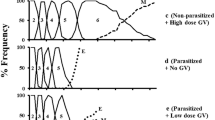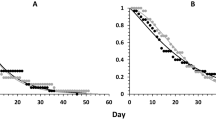Summary
The endoparasitic larvae of two entomophagous Hymenoptera, Lissonota dubia Hgn. (Ichn.) and Apanteles tedellae Nixon (Brac.), both parasitizing the larvae of the Tortricid moth, Epiblema tedella Cl., suppress the development of the host's gonads to a different extent. Apanteles blocks growth and differentiation of the organs when the host larva has reached the late first or early second instar; whereas the inhibitory effect of Lissonota becomes evident in the host's 4th and 5th larval instar.
Apanteles and Lissonota injure the „Peritonealhülle“, i.e. the external envelope of the young gonads, which then even partly disappears in the hosts of Apanteles. The „Peritonealhülle“ of the testes remains a thin layer of connective tissue, that of the ovaries begins storing fat in the second instar, thus developing to a typical fat-body tissue. During the change of structure and function the female „Peritonealhülle“ seems to loose its susceptibility for the parasitic effect.
The block of the germcells' development in the first instar of the host by Apanteles might be the cause of the internal covertissue's (i.e. the „Follikelwand“ and the „Ovariolenwand“, respectively) being unable to differentiate itself normally. By these circumstances the establishment of the internal septa is usually prevented and consequently the division of the young organs into four vesicles, i.e. „Follikel“ and „Ovariolen“, respectively, is not performed.
The pathologies observed in the young gonads of parasitized Epiblema larvae seem to be caused by humoral interferences of the parasite larvae, the chemical bases of which are still unknown.
Zusammenfassung
Die endoparasitischen Larven der beiden entomophagen Hymenopterenarten Lissonota dubia Hgn. (Ichn.) und Apanteles tedellae Nixon (Brac.) stören die Entwicklung der Gonadenanlagen in den Larven ihres Wirts Epiblema tedella Cl. in sehr unterschiedlichem Ausmaß. Während Wachstum und histologische Differenzierung der Gonadenanlagen durch Apanteles schon beim Übergang vom 1. zum 2. Wirtslarvenstadium blockiert werden, ruft Lissonota erst im 4. und 5. Wirtsstadium eine Entwicklungshemmung hervor.
Beide Parasitenarten schädigen die Peritonealhülle der Organanlagen. In Apanteles-Wirten kommt es sogar zum teilweisen Verschwinden dieser äußeren Hüllschicht. Die Peritonealhülle der Ovaranlagen erfüllt im Gegensatz zu jener der Testisanlagen teilweise die Funktion eines Speichergewebes (Fettkörpers) und übernimmt diese offensichtlich erst am Ende des 1. Larvenstadiums. Als Speichergewebe scheint sie ihre Empfindlichkeit für die Parasitenwirkung weitgehend zu verlieren und infolgedessen erhalten zu bleiben, wenn sie vom störenden Einfluß erst in dieser Phase betroffen wird.
In Apanteles-Wirten scheint die frühe Blockierung der Keimzellenentwicklung die Ursache dafür zu sein, daß sich die Follikelwand der Testes und die ihr entsprechende Ovariolenwand der Ovaranlagen nicht normal differenzieren können und somit die Bildung der jeweils vier Keimfächer weitgehend oder ganz unterbleibt.
Die pathologischen Erscheinungen an den Gonadenanlagen der parasitierten Epiblema-Larven dürften das Ergebnis einer humoralen Einflußnahme der Parasitenlarven sein, deren stoffliche Basis noch unbekannt ist.
Similar content being viewed by others
Literatur
Baumert-Behrisch, A.: Der Einfluß des Strepsipteren-Parasitismus auf die Geschlechtsorgane einer Homoptere. Zool. Beitr., N. F. 6, 85–126, 291–323 (1960).
Beard, R. L.: Parasitic castration of Anasa tristis de G. by Trichopoda pennipes Fab., and its effect on reproduction. J. Econ. Entom. 33, 269–272 (1940).
Brandenburg, J.: Der Parasitismus der Gattung Stylops an der Sandbiene Andrena vaga Pz. Z. Parasitenk. 15, 457–475 (1953).
Doutt, R. L.: Pathologies caused by insect parasites. In: Steinhaus, E. A., Insect pathology, vol. 2, pp. 393–422. New York-London: Academic Press 1963.
Escherich, K.: Die Forstinsekten Mitteleuropas, Bd. 3, Berlin: Parey 1931.
Führer, E.: Studien über den Fichtennestwickler in Norddeutschland. Holz-Zbl. 90, 1146–1148 (1964a).
Führer, E.: Zum Auftreten des Fichtennestwicklers Epiblema tedella Cl. (Lep., Tortricidae) in Schleswig-Holstein. 2. Mitteilung: Die Parasiten. Z. ang. Ent. 54, 150–163 (1964b).
Führer, E.: Auswirkungen der endoparasitischen Lebensweise entomophager Hymenopterenlarven auf den Wirt. (1. Mitteilung). Verh. dtsch. zool. Ges. Göttingen, 1966, suppl. 30, 375–382 (1967).
Führer, E.: Zur Synchronisation der Entwicklung von Epiblema tedella Cl. (Lep., Tortricidae) und ihres Parasiten Lissonota dubia Hgn. (Hym., Ichneumonidae). Anz. Schädlingskde. Pflanzensch. 44, 165–171 (1971).
Führer, E.: Eine parasitär bedingte Entwicklungshemmung der Flügelimaginalscheiben in den Larven von Epiblema tedella Cl. (Lep., Tortricidae). Z. ang. Ent. 71, 113–120 (1972).
Grünberg, K.: Untersuchungen über die Keim- und Nährzellen in den Hoden und Ovarien der Lepidopteren. Z. wiss. Zool. 74, 327–395 (1903).
Hassan, A. J.: The biology of some British Delphacidae (Homopt.) and their parasites with special reference to the Strepsiptera. Trans Roy. Ent. Soc. London 89, 345–384 (1939).
Kloft, W.: Über den Einfluß des Mermisparasitismus auf den Stoffwechsel und die Organbildung bei Ameisen. Z. Parasitenk. 14, 390–422 (1949).
Lautenschlager, F.: Die Embryonalentwicklung der weiblichen Keimdrüse bei der Psychide Solenobia triquetrella. Zool. Jb. Abt. Anat. u. Ontog. 56, 121–162 (1932).
Mackauer, M.: Histologische Untersuchungen an parasitierten Blattläusen. Z. Parasitenk. 19, 322–352 (1959).
McGugan, B. M.: Certain host-parasite relationships involving the spruce budworm. Can. Ent. 87, 178–187 (1955).
Novak, V. J.: Insektenhormone. Prag: Tschech. Akad. Wiss. 1959.
Omura, S.: Studies on the reproductive system of the male of Bombyx mori. I. Structure of the testis and the intratesticular behaviour of the spermatozoa. J. Facul. Agr. Hokkaido Imp. Univ., Sapporo 38, 152–179 (1936).
Raatikainen, M.: The effect of different sexes of the parasite Elenchus tenuicornis (Kirby) on the morphology of the adult Javesella pellucida (F.) (Hom., Delphacidae). Ann. Ent. Fenn. 32, 138–146 (1966).
Romeis, B.: Mikroskopische Technik, 16. Aufl. München-Wien: Oldenbourg 1968.
Ruckes, H.: Notes on the male genital system in certain Lepidoptera. Ann. Ent. Soc. Amer. 12, 192–209 (1919).
Rühm, W.: Die Nematoden der Ipiden. — Parasitol. Schriftenrhe. Jena, Nr. 6, 436 pp. (1956).
Salt, G.: A further study of the effect of stylopization on wasps. — J. exp. Zool. 59, 133–166 (1931).
Schedl, K. E., Schedl, Ch.: Der Fichtennestwickler (Epiblema tedella Cl.), 132 pp. Klagenfurt: 1951.
Schneider, K.: Die Entwicklung des Eierstockes und Eies von Deilephila euphorbiae. Arch. Zellforsch. 14, 79–143 (1917).
Smith, O. J.: Biology and behaviour of Microctonus vittatae Muesebeck (Braconidae) with descriptions of its immature stages. Univ. Calif. (Berkeley) Publs. Entomol. 9, 315–344 (1952).
Weber, H.: Grundriß der Insektenkunde, 3. Aufl. Stuttgart: G. Fischer 1954.
Wheeler, W. M.: The effects of parasitic and other kinds of castration in insects. J. exp. Zool. 8, 377–438 (1910).
Author information
Authors and Affiliations
Additional information
Die Untersuchungen wurden dankenswerterweise durch die Deutsche Forschungsgemeinschaft gefördert.
Rights and permissions
About this article
Cite this article
Führer, E. Der Einfluß zweier Endoparasiten auf die Gonadenentwicklung in den Larven von Epiblema (=Eucosma) tedella Cl. (Lep., Tortricidae). Z. Parasitenk. 41, 187–206 (1973). https://doi.org/10.1007/BF00329486
Received:
Issue Date:
DOI: https://doi.org/10.1007/BF00329486




